Lincoln porcelain painter Peg Pelter celebrates Nebraska wildlife.
Enlarge
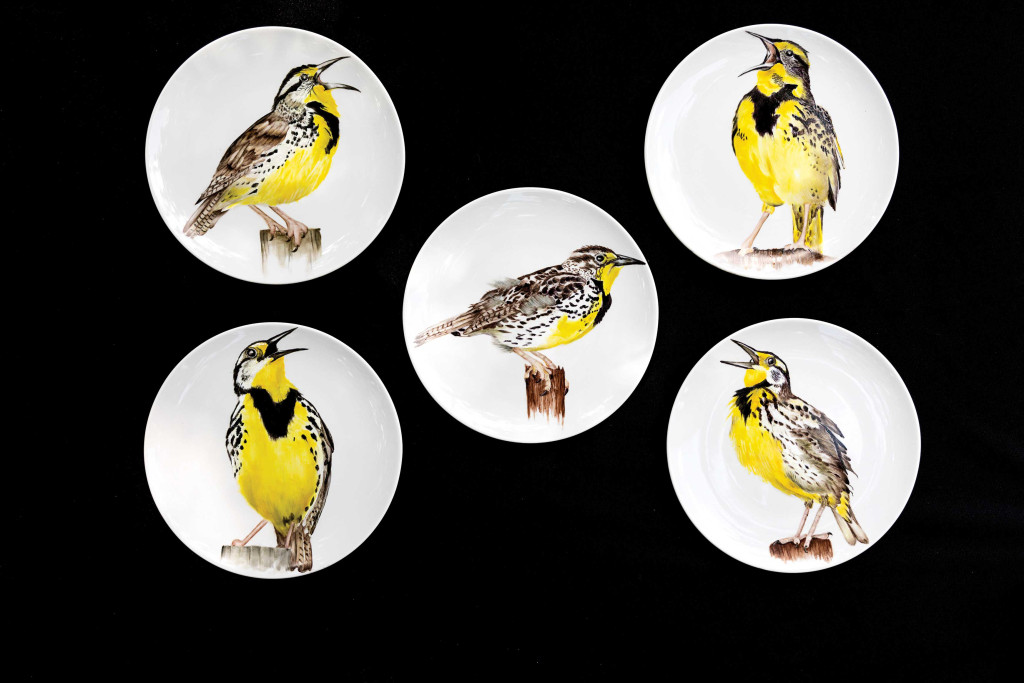
Photo by Jenny Nguyen-Wheatley, Nebraskaland Magazine
Story and photos by Jenny Nguyen-Wheatley
“My joke is that if you paint a leaf too big or a petal too big, nobody really notices. But if you get the nose too big on a dog or the beak too big on a chicken, people notice,” said Peg Pelter of Lincoln, explaining the difference between painting traditional subjects such as florals and fruit to animals. Some of her most recent work highlights Nebraska wildlife.
In fall 2022, Pelter began painting a series of plates that would be unveiled at The Landing retirement community center in south Lincoln. The porcelain painter produced a total of 39 pieces for her exhibit: 16 plates of native wildflowers; six pheasants; nine black-footed ferrets, a Nebraska endangered species; six meadowlarks, our state bird; and a couple of landscapes. She called the collection “Nebraska Treasure.”
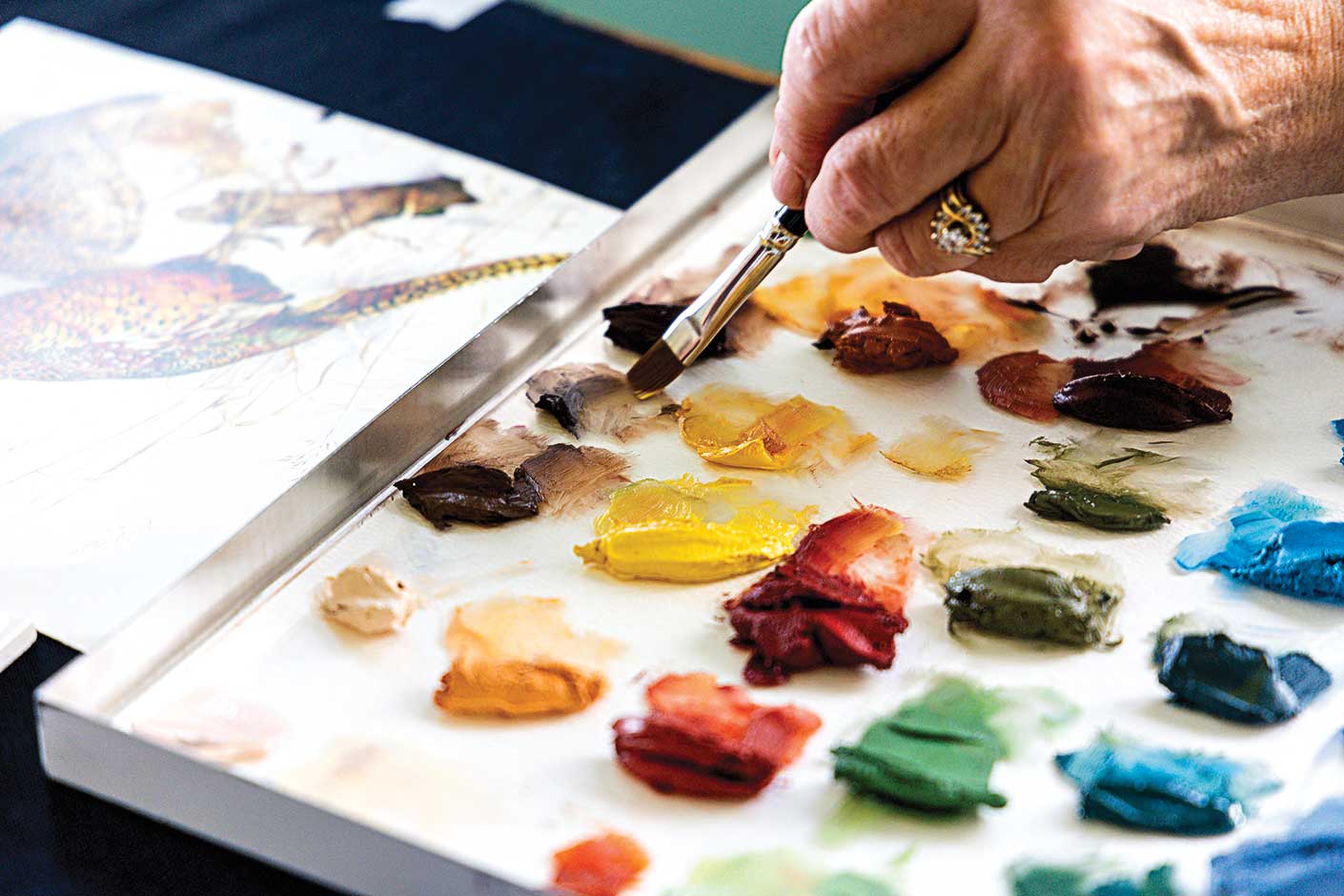
Painting History
Past visitors at Arbor Lodge State Historical Park and Arboretum near Nebraska City might’ve caught the artist at work in the Morton Mansion. During living history weekends fall 2022 and spring 2023, they might’ve spotted Pelter working on pieces for her “Nebraska Treasure” exhibit. She paints in the sunroom where the light is best and has been doing so for about 12 years. Pelter’s presence is a tie-in to the mansion’s history — Caroline Joy Morton, wife of J. Sterling Morton, was a porcelain painter, as were many upper-middle class women in the 1890s to 1920s.
China painting came to the United States in the late 19th century by way of the world expositions in Philadelphia and Chicago, which introduced Americans to cultures worldwide. First Lady Caroline Harrison, wife of 23rd President Benjamin Harrison, could be credited for the mania around china painting in the U.S. Harrison’s talent and interest in the medium captivated women all over the country, and many of her pieces are on display in the White House today, including her design of the presidential china during her husband’s term, which would’ve been used during state dinners.
The rising popularity of this pastime also coincided with a burgeoning middle class that found itself with more leisure time, a major shift in American society as a result of the post-Civil War Industrial Revolution. China painting was deemed an acceptable hobby for women because it was a way for them to decorate and beautify their homes.
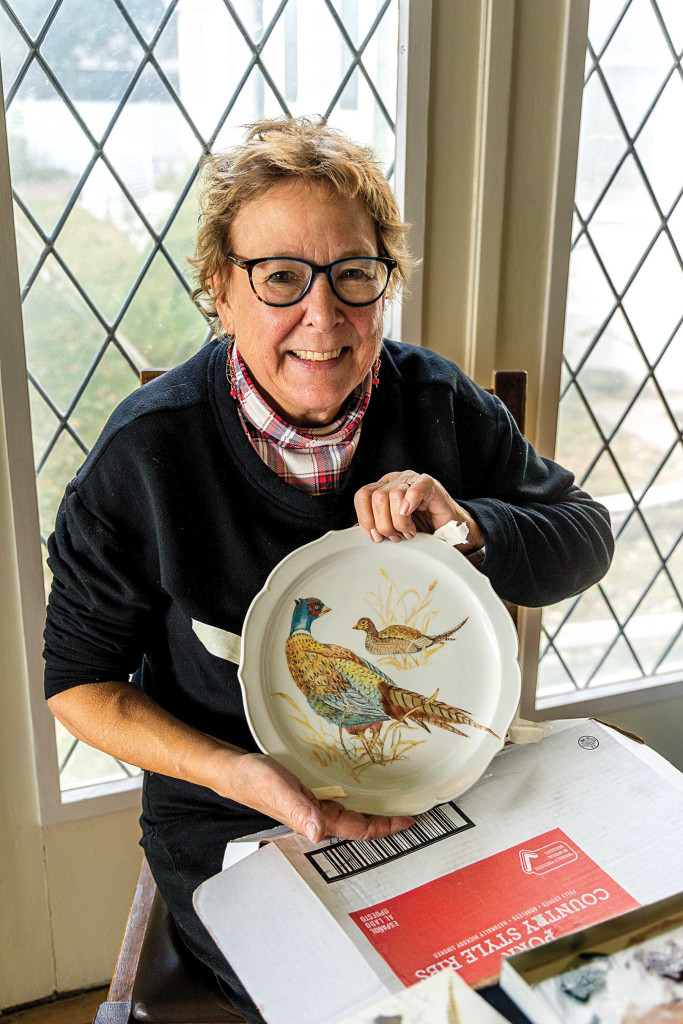
“Nobody ever painted china in a soddie,” Pelter explained. “You had to have the time and access to a kiln and access to porcelain. Now porcelain is cheaper than dirt, but back in the 1890s to 1920s, china was expensive.”
Then in the 1920s, china painting died out, Pelter said — a casualty of the Great Depression and World War II.
The Second Wave
Trends come and go, and china painting was no exception. Four decades later, the art form made its comeback in America. Pelter, a college student at the University of Nebraska-Lincoln at the time, fortuitously met a china painter at the Gateway Mall in Lincoln in 1976.
“I watched her for a while and thought, ‘I can do that.’ So, I took her card and ended up taking lessons with her. To be honest with you, it was pretty inexplicable,” Pelter said. “I was a college student, and these lessons were $75 — I didn’t have that kind of money, but somehow I did it.”
Like many during that time, Pelter had caught the second heyday of china painting, which happened in the 1960s and 1970s, thanks to the advent of the electric kiln. Previously, kilns were kerosene- or gas-fired, and they were dangerous. Also, the exhaust from these old kilns meant that artists couldn’t store them in the basement or garage, another inconvenience.
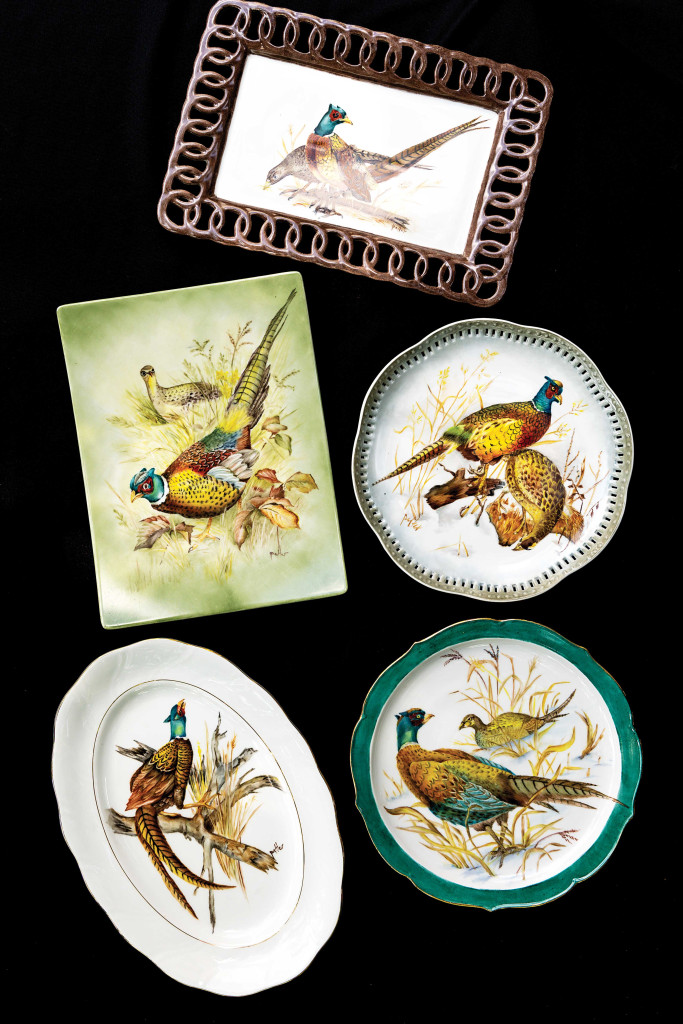
When Pelter and her husband, Larry, built their current home in Lincoln in 1985, they built Pelter an art studio. She took a leap and decided to turn this decade-long hobby into a career and began traveling to countless art and craft shows. Pelter also made a living painting tiles to decorate the kitchens, bathrooms and fireplaces in peoples’ homes. Her dedication to this art form has spanned close to half a century.
Painting on Porcelain
Pelter compares painting on porcelain to “painting on glass,” as there’s no texture to hold the paint in place, as opposed to canvas or paper, so technique and brush control are important skills. Another challenging aspect of china painting is that the objects she paints on are rarely completely flat.
“Most other forms of painting are done on flat rectangles, so it takes a sense of design to get the image on an appropriate piece of china in an appropriate way,” Pelter said. “It’s funny how you get hooked on things. For some reason, I’m really hooked on porcelain. Canvas and paper just seem dull. They don’t appeal to me.”
With china painting, pigments are applied onto a fired, glazed surface — such as a plate or bowl that you’d purchase. To set the image, the piece of porcelain is essentially fired again to about 1,500 degrees Fahrenheit, during which the glaze softens, allowing the pigments to “fall into” the glaze.
“As the glaze cools, those pigments get caught in the glaze. And so, it becomes a permanent surface. The image is no longer lying on top of the glaze — it’s lying in the glaze,” Pelter explained.
Often, Pelter’s paintings may be inspired by a single color. For example, she might feel like painting something “red” one day. The next step would be deciding what that “red” subject would be, after which she searches for a photograph to use as reference. Pelter claims to have one of the largest clip files in existence, though Google has been useful in recent years. Due to the challenging nature of painting animals, the six pheasant plates were her favorite to paint in the Nebraska Treasure collection, followed by the meadowlarks for their vibrant, contrasting hues.
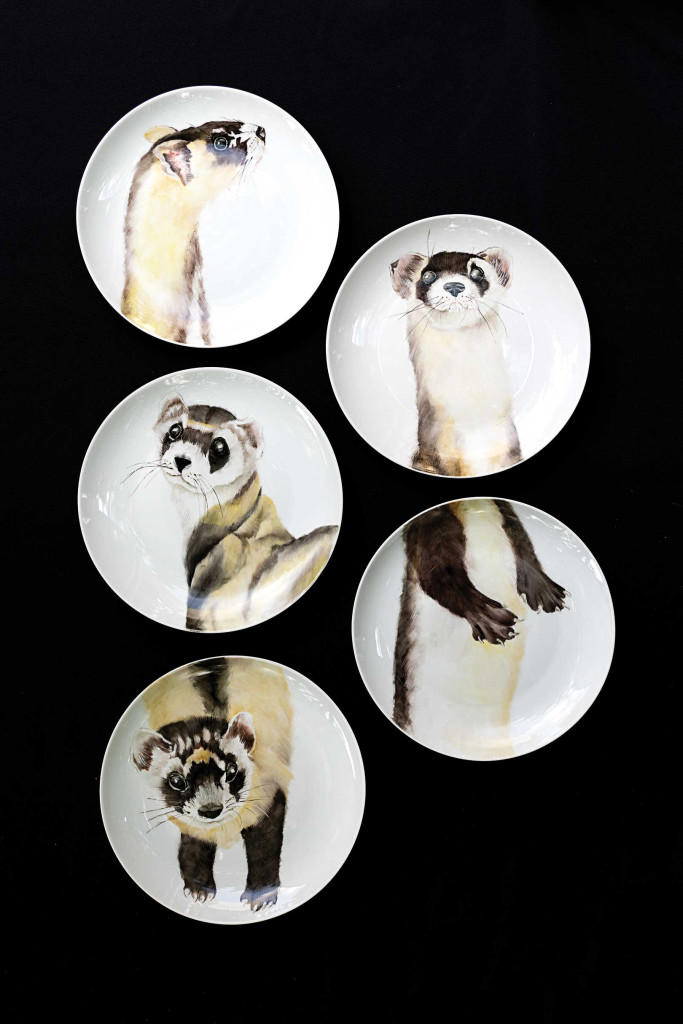
“Most of my paintings came from photographs. I’m sure quite a few of them came from Nebraskaland Magazine,” Pelter said. While painting her wildflower pieces, she often thought of the work of Michele Farrar, who used her late husband’s photographs to create etchings of Nebraska plants and flowers — Jon Farrar was a Nebraskaland photographer and writer for over 40 years.
The black-footed ferret is one of Pelter’s more obscure subjects. She felt inspired to paint the ferret, a species listed as endangered in Nebraska and federally, after a visit to a nearby state park, where she happened to read some educational material on the weasel. Once thought to be extinct due to habitat loss, black-footed ferrets were rediscovered in the 1980s in Wyoming. The ferrets’ historic range included the Great Plains, mountain basins and semi-arid grasslands in 12 states, including Nebraska. Biologists guess there are only 300-350 individuals left in the wild in all of North America.
“For some reason, that intrigued me — the idea that these animals are out there somewhere, but nobody knows where they’re at,” Pelter said.
Since being on display at The Landing in October and November 2023, Pelter’s Nebraska Treasure collection has been “on the road.” It moved to the Unitarian Church in winter 2023 and then was displayed at Bethany Christian Church in Lincoln through March.
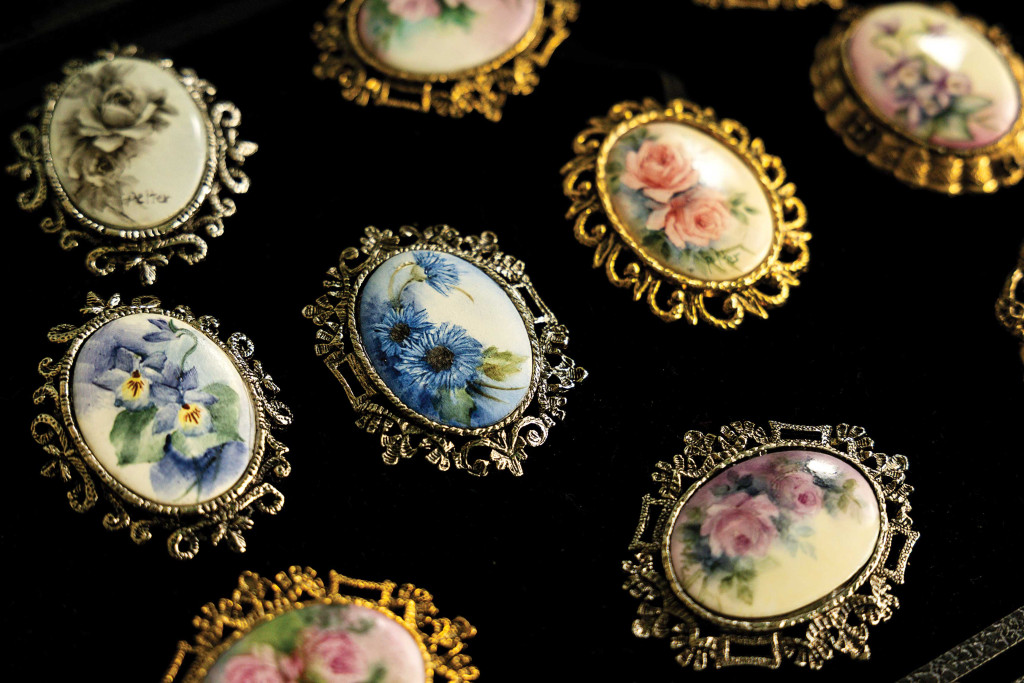
Pelterhouse
Though china painting has fallen out of fashion again, there remains a small, dedicated community still practicing this art. Pelter travels all over the country to share her skills at arts and craft seminars, and she and Larry, who makes pottery, stay at Custer State Park in South Dakota three to four weeks every summer/fall as artists in residency, where they set up a gift shop and do demonstrations.
And who knows. Consider the return of sourdough breadmaking or high-waisted jeans. A third china painting revival just might be on the horizon. In the meantime, keep up with Peg Pelter’s work on Facebook at Pelterhouse.
Catch Peg Pelter at a living history event at the Morton Mansion, part of Arbor State Lodge Historical Park and Arboretum near Nebraska City. She is scheduled to appear Oct. 18-20, Nov. 30 and Dec. 1, 2024.
The post Wildlife Porcelain Painter appeared first on Nebraskaland Magazine.
















